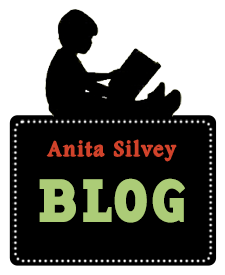Where Do All the Prizes Go?
Authors with common sense keep their thoughts to themselves about the prizes given to children’s books. But I have always refused to be silenced when it comes to opinions about awards, and age does not seem to be bestowing upon me the gift of going gently into the good night.
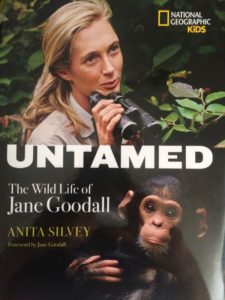 This week I get to do something quite extraordinary. I’ll be in Cleveland, Ohio, to receive the Norman A. Sugarman Award, given for a new biography for children, in this case Untamed: The Wild Life of Jane Goodall. Sponsored by the Joan G. Sugarman family, and administered by the Cleveland Public Library, the award bestows a cash stipend and stands as one of the few prizes earmarked for writers of nonfiction.
This week I get to do something quite extraordinary. I’ll be in Cleveland, Ohio, to receive the Norman A. Sugarman Award, given for a new biography for children, in this case Untamed: The Wild Life of Jane Goodall. Sponsored by the Joan G. Sugarman family, and administered by the Cleveland Public Library, the award bestows a cash stipend and stands as one of the few prizes earmarked for writers of nonfiction.
In the 1970s Milton Meltzer wrote a ground-breaking article for Horn Book, “Where Do All the Prizes Go?” In it he bemoaned the dearth of attention for writers of nonfiction. Editor of the Horn Book Paul Heins found Milton’s arguments so convincing that he added a nonfiction category to the Boston Globe Horn Book Awards. Others followed, including the Washington D. C. Children’s Book Guild, ALSC with the Siebert Award, and YALSA with the Nonfiction Award. All of these prizes have been welcome additions to the landscape.
But, unfortunately, Milton’s arguments remain largely true. Any guesses about the last time a work of narrative nonfiction won the Newbery? As editor of the Horn Book I cheered the selection of Russell Freedman’s Lincoln: A Photobiography in 1988. But thirty years seems a very long time to overlook the contributions of nonfiction writers. Recent reading research indicates that around 50% of our children prefer to pick up information books – they want to know about things that really happened. With writers like Steve Sheinkin and Candace Fleming creating fabulous books year after year – not to mention a host of other unsung authors – it seems a shame that the top writing prize, and so many other awards, overlook their accomplishments.
 I am grateful that the Sugarman Award exists and that I will be able to express my thanks in Cleveland. Awards make a profound impact on authors– encouraging us to keep going, making us believe that the kinds of books we love, and write, have value. I just hope that sometime in the not-so-distant future I can stand and applaud when the Newbery or another major prize goes to a fellow nonfiction writer. We need these true stories about our world, ones that inspire and educate our children.
I am grateful that the Sugarman Award exists and that I will be able to express my thanks in Cleveland. Awards make a profound impact on authors– encouraging us to keep going, making us believe that the kinds of books we love, and write, have value. I just hope that sometime in the not-so-distant future I can stand and applaud when the Newbery or another major prize goes to a fellow nonfiction writer. We need these true stories about our world, ones that inspire and educate our children.
Pete Seeger in Spain
On Wednesday, September 14, at 6:30 p.m. at the Boston (MA) Public Library, the new recipient of the Associates of the Boston Public Library’s Writer-in-Residency Fellowship, Lisa Rosinsky, will be reading from her novel Robin & Mariana. The Writer-in-Residency Program at the BPL bestows not only an office and research support for someone at the beginning of her or his writing career but also an incredibly generous stipend. Lisa already has many other achievements to her credit –including a stint on “Wait, Wait, Don’t Tell Me” – but I am grateful to her for making judging such a pleasant experience. Writers who unite judging panels should get special compensation.
However, what made me particularly happy the day we chose Lisa happened after the meeting. Then Charles Coe, poet and writing guru, approached me with a Pete Seeger story that I wish I had known while writing my book.
![By Dan Tappan (originally posted to Flickr as p1190509.jpg) [CC BY-SA 2.0 (http://creativecommons.org/licenses/by-sa/2.0)], via Wikimedia Commons](https://www.anitasilvey.com/blog/wp-content/uploads/2016/09/Pete_Seeger11.jpg)
Right before Pete entered the stage for a concert in Spain, he was approached by a government official with a list of songs that should not be performed. Looking over that paper, Pete saw that his entire program for the concert had been forbidden. Someone else might have been daunted by this turn of events – but not Pete.
First he told his audience what had happened. And then he announced that he wouldn’t sing the songs — but would play the chords. The audience needed to provide the words. That day an entire stadium of Spanish Pete Seeger fans joined him to create a unique and special event. This story, like so many of the ones about Pete Seeger, reaffirms the importance of the First Amendment in the lives of artists.
I look forward to hearing Lisa Rosinsky read at the Boston Public Library, grateful that she can present uncensored work, both to her judges and to her listeners.
Pete Seeger Videos
While writing Let Your Voice Be Heard: The Life and Times of Pete Seeger, I would often take a break and watch a video clip of Pete. His enthusiasm and his ability to engage an audience always inspired me. Of all the videos I viewed, I have returned to one of them many times.
For about ten years Pete was blacklisted and harassed, unable to travel from New York to New Jersey without notifying the court. Although the House of Un-American Activities found no evidence of any wrong-doing on Pete’s part, he still faced the recriminations of those targeted during the McCarthy era. Finally, when cleared of all charges, Pete and his family headed around the world, where he performed before adoring fans and finally got to appear on television.
In his first concert on the tour in Australia, Pete appears neither bitter nor angry. He entices his audience to yodel and sing along. And then, he introduces Australian audiences to an artist that Pete believes will revolutionize American music. This video of Pete performing Bob Dylan’s “A Hard Rain’s a-Gonna Fall” always brings tears to my eyes. Even after all the adversity that Pete had faced, he remains generous and supportive of others. That trait will characterize Pete Seeger all his life.
To preview Let Your Voice Be Heard, use the arrow buttons to navigate through the book.
The Golden Age of Illustration
When I finally began writing my biography of Pete Seeger, one of my main decisions involved the story I would tell. I had roughly 15,000 words — and I could have written that much about any one year of Pete’s life. In fact, I needed five drafts to craft a clean and uncluttered saga. In the end I decided not to dwell on Pete’s music, which would be unknown by contemporary children, but focused instead on Pete as a social activist. After all he stood on the right side of history on unions, First Amendment rights, Civil Rights, and the Peace and Environmental movements.
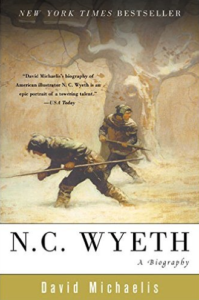
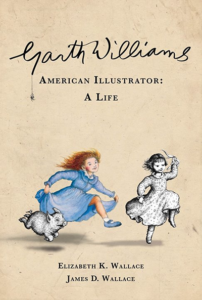 In analyzing narrative nonfiction, readers always need to ask what story an author has chosen to tell. Last week I read a fabulous new adult biography, Elizabeth and James Wallace’s Garth Williams. It now stands on my bookshelf alongside another superb biography, N.C. Wyeth by David Michaelis. If you love the golden age of illustration, both books contain abundant information. But the story they tell differs. Michaelis focuses on the psychology, almost family pathology, of Wyeth. Basically he puts Wyeth on a psychiatrist’s couch for an in-depth analysis. But the Wallaces, who do mention some of the bizarre details of Garth Williams’s life, don’t dwell there. They explore his relationships with Laura Ingalls Wilder, E. B. White, and Margaret Wise Brown among others. They show letters between Williams and his editor Ursula Nordstrom. Even better — be still my beating heart — they provide contract and revenue details. Since I teach a course in the History of Children’s Book Publishing at Simmons College, I cannot even begin to tell you how difficult, almost impossible, it is to locate that type of information. In short, I recommend both books. But the Garth Williams biography satisfied me more as a reader — because of the story the writers set out to tell.
In analyzing narrative nonfiction, readers always need to ask what story an author has chosen to tell. Last week I read a fabulous new adult biography, Elizabeth and James Wallace’s Garth Williams. It now stands on my bookshelf alongside another superb biography, N.C. Wyeth by David Michaelis. If you love the golden age of illustration, both books contain abundant information. But the story they tell differs. Michaelis focuses on the psychology, almost family pathology, of Wyeth. Basically he puts Wyeth on a psychiatrist’s couch for an in-depth analysis. But the Wallaces, who do mention some of the bizarre details of Garth Williams’s life, don’t dwell there. They explore his relationships with Laura Ingalls Wilder, E. B. White, and Margaret Wise Brown among others. They show letters between Williams and his editor Ursula Nordstrom. Even better — be still my beating heart — they provide contract and revenue details. Since I teach a course in the History of Children’s Book Publishing at Simmons College, I cannot even begin to tell you how difficult, almost impossible, it is to locate that type of information. In short, I recommend both books. But the Garth Williams biography satisfied me more as a reader — because of the story the writers set out to tell.
Let Your Voice Be Heard
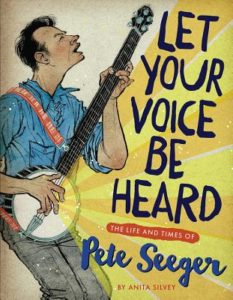 In August a book that I had worked on for eight years, Let Your Voice Be Heard: The Life and Times of Pete Seeger finally became available to the world. With that length of research and writing time, most people would assume that as the author I managed to locate any material that might be of interest for the project. But a very predictable thing happens when you publish a book. People who read it began to tell you stories, send you photos, or provide research information that you would have loved to have seen—when you were writing the book. So this blog will focus on two things: some of the material that I found, too late to incorporate in the book; and audio, video, or photographic material that can be used to augment the sharing of Let Your Voice Be Heard with children.
In August a book that I had worked on for eight years, Let Your Voice Be Heard: The Life and Times of Pete Seeger finally became available to the world. With that length of research and writing time, most people would assume that as the author I managed to locate any material that might be of interest for the project. But a very predictable thing happens when you publish a book. People who read it began to tell you stories, send you photos, or provide research information that you would have loved to have seen—when you were writing the book. So this blog will focus on two things: some of the material that I found, too late to incorporate in the book; and audio, video, or photographic material that can be used to augment the sharing of Let Your Voice Be Heard with children.
At a memorial service for Marcia Brown late this spring, the charming Brian Keough, Department Head, University Libraries at SUNY, Albany, alerted me to the Pete Seeger collection of audio clips and photos in their archives. In one of the audio clips from 1962 Pete hears the song Guantanamera for the first time, sung by Hector Angula.
http://library.albany.edu/archive/seeger. I loved hearing this segment – it reminded me that Pete was like me a primary source fanatic, but in his case he searched for authentic folk music.
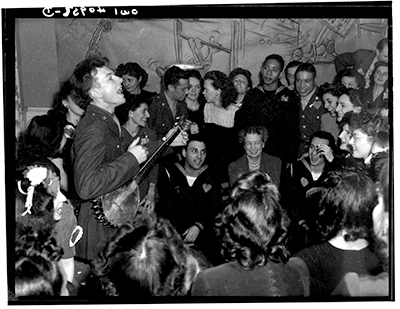
Are there other video or audio clips of Pete that you particularly like? Next week I’ll talk about some of my favorites.
